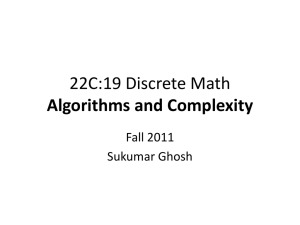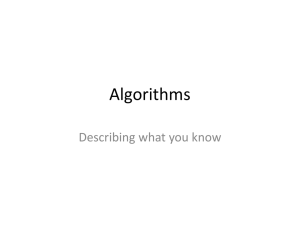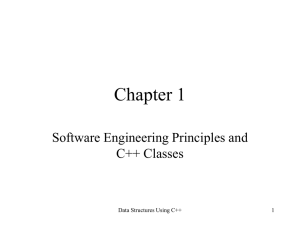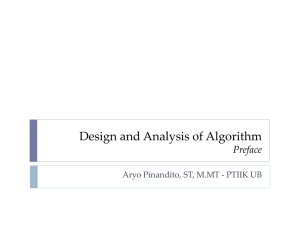Document
advertisement
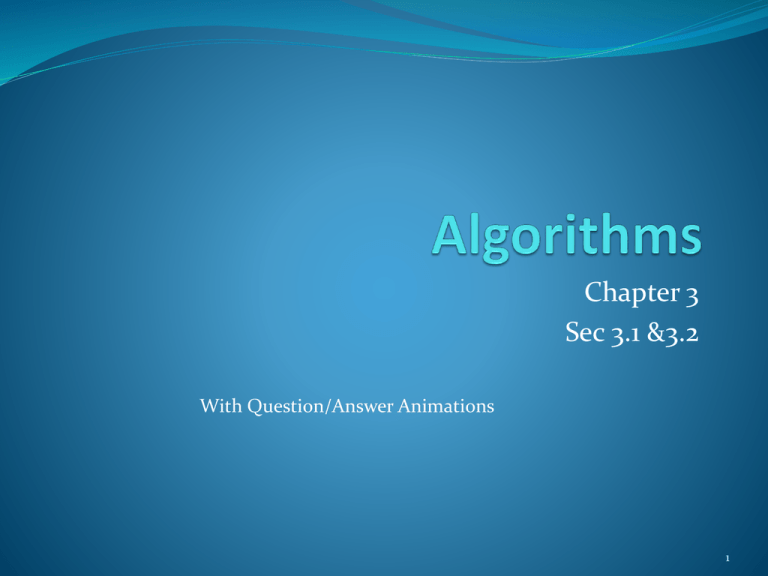
Chapter 3
Sec 3.1 &3.2
With Question/Answer Animations
1
Chapter Summary
Algorithms
Example Algorithms
Algorithmic Paradigms
Growth of Functions
Big-O and other Notation
Complexity of Algorithms
2
Section 3.1
3
Section Summary
Properties of Algorithms
Algorithms for Searching and Sorting
Greedy Algorithms
Halting Problem
4
Problems and Algorithms
In many domains, there are key general problems that
ask for output with specific properties when given
valid input.
The first step is to precisely state the problem, using
the appropriate structures to specify the input and the
desired output.
We then solve the general problem by specifying the
steps of a procedure that takes a valid input and
produces the desired output. This procedure is called
an algorithm.
5
Algorithms
Abu Ja’far Mohammed Ibin Musa Al-Khowarizmi
(780-850)
Definition: An algorithm is a finite sequence of precise
instructions for performing a computation or for
solving a problem.
Example: Describe an algorithm for finding the maximum
value in a finite sequence of integers.
Solution: Perform the following steps:
1.
2.
3.
4.
Set the temporary maximum equal to the first integer in the
sequence.
Compare the next integer in the sequence to the temporary
maximum.
If it is larger than the temporary maximum, set the temporary
maximum equal to this integer.
Repeat the previous step if there are more integers. If not, stop.
When the algorithm terminates, the temporary maximum is the
largest integer in the sequence.
6
Specifying Algorithms
Algorithms can be specified in different ways. Their steps can be
described in English or in pseudocode.
Pseudocode is an intermediate step between an English language
description of the steps and a coding of these steps using a
programming language.
The form of pseudocode we use is specified in Appendix 3. It uses
some of the structures found in popular languages such as C++ and
Java.
Programmers can use the description of an algorithm in pseudocode to
construct a program in a particular language.
Pseudocode helps us analyze the time required to solve a problem
using an algorithm, independent of the actual programming language
used to implement algorithm.
7
Properties of Algorithms
Input: An algorithm usually has input values from a
specified set.
Output: From the input values, the algorithm produces the
output values from a specified set. The output values are
the solution.
Correctness: An algorithm should produce the correct
output values for each set of input values.
Finiteness: An algorithm should produce the output after
a finite number of steps for any input.
Effectiveness: It must be possible to perform each step of
the algorithm correctly and in a finite amount of time.
Generality: The algorithm should work for all problems of
the desired form.
8
Finding the Maximum Element in a
Finite Sequence
The algorithm in pseudocode:
procedure max(a1, a2, …., an: integers)
max := a1
for i := 2 to n
if max < ai then max := ai
return max{max is the largest element}
Does this algorithm have all the properties listed on
the previous slide?
Assignment: Draw a flowchart for this algorithm.
9
Some Example Algorithm Problems
Three classes of problems will be studied in this
section.
1.
2.
3.
Searching Problems: finding the position of a
particular element in a list.
Sorting problems: putting the elements of a list into
increasing order.
Optimization Problems: determining the optimal
value (maximum or minimum) of a particular quantity
over all possible inputs.
10
Searching Problems
Definition: The general searching problem is to locate
an element x in the list of distinct elements a1,a2,...,an,
or determine that it is not in the list.
The solution to a searching problem is the location of
the term in the list that equals x (that is, i is the solution
if x = ai) or 0 if x is not in the list.
For example, a library might want to check to see if a
patron is on a list of those with overdue books before
allowing him/her to checkout another book.
We will study two different searching algorithms; linear
search and binary search.
11
Linear Search Algorithm
The linear search algorithm locates an item in a list by examining elements in
the sequence one at a time, starting at the beginning.
First compare x with a1. If they are equal, return the position 1.
If not, try a2. If x = a2, return the position 2.
Keep going, and if no match is found when the entire list is scanned,
return 0.
procedure linear search(x:integer,
a1, a2, …,an: distinct integers)
i := 1
while (i ≤ n and x ≠ ai)
i := i + 1
if i ≤ n then location := i
else location := 0
return location{location is the subscript
of the term that equals x, or is 0 if x is
not found}
Assignment: Draw a
flowchart for this
algorithm.
12
Binary Search
Assume the input is a list of items in increasing order.
The algorithm begins by comparing the element to be found
with the middle element.
If the middle element is lower, the search proceeds with the upper
half of the list.
If it is not lower, the search proceeds with the lower half of the list
(through the middle position).
Repeat this process until we have a list of size 1.
If the element we are looking for is equal to the element in the list,
the position is returned.
Otherwise, 0 is returned to indicate that the element was not
found.
In Section 3.3, we show that the binary search algorithm is much
more efficient than linear search.
13
Binary Search
Here is a description of the binary search algorithm in
pseudocode.
procedure binary search(x: integer, a1,a2,…, an: increasing integers)
i := 1 {i is the left endpoint of interval}
j := n {j is right endpoint of interval}
while i < j
m := ⌊(i + j)/2⌋
if x > am then i := m + 1
else j := m
if x = ai then location := i
else location := 0
return location{location is the subscript i of the term ai equal to x, or 0 if
x is not found}
Assignment: Draw a flowchart for this algorithm.
14
Binary Search
Example: The steps taken by a binary search for 19 in the list:
1 2 3 5 6 7 8 10 12 13 15 16 18 19 20 22
1.
The list has 16 elements, so the midpoint is 8. The value in the 8th position is 10. Since
19 > 10, further search is restricted to positions 9 through 16.
1 2 3 5 6 7 8 10 12 13 15 16 18 19 20 22
2.
The midpoint of the list (positions 9 through 16) is now the 12th position with a value
of 16. Since 19 > 16, further search is restricted to the 13th position and above.
1 2 3 5 6 7 8 10 12 13 15 16 18 19 20 22
3.
The midpoint of the current list is now the 14th position with a value of 19. Since
19 ≯ 19, further search is restricted to the portion from the 13th through the 14th
positions .
1 2 3 5 6 7 8 10 12 13 15 16 18 19 20 22
4.
The midpoint of the current list is now the 13th position with a value of 18.
Since 19> 18, search is restricted to the portion from the 18th position through the
18th.
1 2 3 5 6 7 8 10 12 13 15 16 18 19 20 22
5.
Now the list has a single element and the loop ends. Since 19=19, the location 16 is
returned.
15
Sorting
To sort the elements of a list is to put them in increasing order
(numerical order, alphabetic, and so on).
Sorting is an important problem because:
A nontrivial percentage of all computing resources are devoted to
sorting different kinds of lists, especially applications involving large
databases of information that need to be presented in a particular order
(e.g., by customer, part number etc.).
An amazing number of fundamentally different algorithms have been
invented for sorting. Their relative advantages and disadvantages have
been studied extensively.
Sorting algorithms are useful to illustrate the basic notions of computer
science.
A variety of sorting algorithms are studied in this book; binary,
insertion, bubble, selection, merge, quick, and tournament.
In Section 3.3, we’ll study the amount of time required to sort a list
using the sorting algorithms covered in this section.
16
Bubble Sort
Bubble sort makes multiple passes through a list. Every
pair of elements that are found to be out of order are
interchanged.
procedure bubblesort(a1,…,an: real numbers
with n ≥ 2)
for i := 1 to n− 1
for j := 1 to n − i
if aj >aj+1 then interchange aj and aj+1
{a1,…, an is now in increasing order}
Assignment: Draw a flowchart for this algorithm.
17
Bubble Sort
Example: Show the steps of bubble sort with 3 2 4 1 5
At the first pass the largest element has been put into the correct position
At the end of the second pass, the 2nd largest element has been put into the correct
position.
In each subsequent pass, an additional element is put in the correct position.
18
Insertion Sort
Insertion sort begins with the 2nd element. It compares the 2nd element
with the 1st and puts it before the first if it is not larger.
procedure insertion sort
(a1,…,an:
•Next the 3rd element is put into
the correct position among the
real numbers with n ≥ 2)
first 3 elements.
for j := 2 to n
•In each subsequent pass, the n+1st
i := 1
element is put into its correct
while aj > ai
position among the first n+1
i := i + 1
elements.
m := aj
•Linear search is used to find the
for k := 0 to j − i − 1
correct position.
aj-k := aj-k-1
Assignment: Draw a flowchart for this
ai := m
algorithm.
{Now a1,…,an is in increasing order}
19
Insertion Sort
Example: Show all the steps of insertion sort with the
input: 3 2 4 1 5
i. 2 3 4 1 5 (first two positions are interchanged)
ii. 2 3 4 1 5 (third element remains in its position)
iii. 1 2 3 4 5 (fourth is placed at beginning)
iv. 1 2 3 4 5 (fifth element remains in its position)
20
Greedy Algorithms
Optimization problems minimize or maximize some parameter over all possible
inputs.
Among the many optimization problems we will study are:
Finding a route between two cities with the smallest total mileage.
Determining how to encode messages using the fewest possible bits.
Finding the fiber links between network nodes using the least amount of fiber.
Optimization problems can often be solved using a greedy algorithm, which
makes the “best” choice at each step. Making the “best choice” at each step does
not necessarily produce an optimal solution to the overall problem, but in
many instances, it does.
After specifying what the “best choice” at each step is, we try to prove that this
approach always produces an optimal solution, or find a counterexample to
show that it does not.
The greedy approach to solving problems is an example of an algorithmic
paradigm, which is a general approach for designing an algorithm. We return to
algorithmic paradigms in Section 3.3.
21
Greedy Algorithms: Making Change
Example: Design a greedy algorithm for making change
(in U.S. money) of n cents with the following coins:
quarters (25 cents), dimes (10 cents), nickels (5 cents), and
pennies (1 cent) , using the least total number of coins.
Idea: At each step choose the coin with the largest possible
value that does not exceed the amount of change left.
1.
2.
3.
4.
If n = 67 cents, first choose a quarter leaving
67−25 = 42 cents. Then choose another quarter leaving
42 −25 = 17 cents
Then choose 1 dime, leaving 17 − 10 = 7 cents.
Choose 1 nickel, leaving 7 – 5 – 2 cents.
Choose a penny, leaving one cent. Choose another penny
leaving 0 cents.
Assignment: Draw a flowchart for this algorithm.
22
Greedy Change-Making Algorithm
Solution: Greedy change-making algorithm for n cents. The
algorithm works with any coin denominations c1, c2, …,cr .
procedure change(c1, c2, …, cr: values of coins, where c1> c2> … > cr ;
n: a positive integer)
for i := 1 to r
di := 0 [di counts the coins of denomination ci]
while n ≥ ci
di := di + 1 [add a coin of denomination ci]
n = n - ci
[di counts the coins ci]
For the example of U.S. currency, we may have quarters, dimes,
nickels and pennies, with c1 = 25, c2 = 10, c3 = 5, and c4 = 1.
23
Proving Optimality for U.S. Coins
Show that the change making algorithm for U.S. coins is optimal.
Lemma 1: If n is a positive integer, then n cents in change using
quarters, dimes, nickels, and pennies, using the fewest coins
possible has at most 2 dimes, 1 nickel, 4 pennies, and cannot
have 2 dimes and a nickel. The total amount of change in dimes,
nickels, and pennies must not exceed 24 cents.
Proof: By contradiction
If we had 3 dimes, we could replace them with a quarter and a
nickel.
If we had 2 nickels, we could replace them with 1 dime.
If we had 5 pennies, we could replace them with a nickel.
If we had 2 dimes and 1 nickel, we could replace them with a
quarter.
The allowable combinations, have a maximum value of 24 cents; 2
dimes and 4 pennies.
24
Proving Optimality for U.S. Coins
Theorem: The greedy change-making algorithm for U.S.
coins produces change using the fewest coins possible.
Proof: By contradiction.
Assume there is a positive integer n such that change can be
made for n cents using quarters, dimes, nickels, and
pennies, with a fewer total number of coins than given by
the algorithm.
2. Then, q̍ ≤ q where q̍ is the number of quarters used in
this optimal way and q is the number of quarters in the
greedy algorithm’s solution. But this is not possible by
Lemma 1, since the value of the coins other than quarters
can not be greater than 24 cents.
3. Similarly, by Lemma 1, the two algorithms must have the
same number of dimes, nickels, and quarters.
1.
25
Greedy Change-Making Algorithm
Optimality depends on the denominations
available.
For U.S. coins, optimality still holds if we add half
dollar coins (50 cents) and dollar coins (100 cents).
But if we allow only quarters (25 cents), dimes (10
cents), and pennies (1 cent), the algorithm no longer
produces the minimum number of coins.
Consider the example of 31 cents. The optimal number
of coins is 4, i.e., 3 dimes and 1 penny. What does the
algorithm output?
26
Greedy Scheduling
S.S. to Slide 29
Example: We have a group of proposed talks with start and end times.
Construct a greedy algorithm to schedule as many as possible in a
lecture hall, under the following assumptions:
When a talk starts, it continues till the end.
No two talks can occur at the same time.
A talk can begin at the same time that another ends.
Once we have selected some of the talks, we cannot add a talk which is
incompatible with those already selected because it overlaps at least
one of these previously selected talks.
How should we make the “best choice” at each step of the algorithm?
That is, which talk do we pick ?
The talk that starts earliest among those compatible with already chosen talks?
The talk that is shortest among those already compatible?
The talk that ends earliest among those compatible with already chosen talks?
27
Greedy Scheduling
Picking the shortest talk doesn’t work.
Start: 8:00 AM
Talk 1
End :9:45 AM
Start: 9:00 AM
Talk 2
End: 10:00 AM
Start: 9:45 AM
Talk 3
End: 11:00 AM
Can you find a counterexample here?
But picking the one that ends soonest does work. The
algorithm is specified on the next page.
28
Greedy Scheduling algorithm
Solution: At each step, choose the talks with the
earliest ending time among the talks compatible with
those selected.
procedure schedule(s1 ≤ s2 ≤ … ≤ sn : start times, e1 ≤ e2 ≤ … ≤ en :
end times)
sort talks by finish time and reorder so that e1 ≤ e2 ≤ … ≤ en
S := ∅
for j := 1 to n
if talk j is compatible with S then
S := S ∅∪{talk j}
return S [ S is the set of talks scheduled]
Will be proven correct by induction in Chapter 5.
29
Halting Problem
Example: Can we develop a procedure that takes as
input a computer program along with its input and
determines whether the program will eventually halt
with that input.
Solution: Proof by contradiction.
Assume that there is such a procedure and call it
H(P,I). The procedure H(P,I) takes as input a program
P and the input I to P.
H outputs “halt” if it is the case that P will stop when
run with input I.
Otherwise, H outputs “loops forever.”
30
Halting Problem
Since a program is a string of characters, we can call
H(P,P). Construct a procedure K(P), which works as
follows.
If H(P,P) outputs “loops forever” then K(P) halts.
If H(P,P) outputs “halt” then K(P) goes into an infinite
loop printing “ha” on each iteration.
31
Halting Problem
Now we call K with K as input, i.e. K(K).
If the output of H(K,K) is “loops forever” then K(K)
halts. A Contradiction.
If the output of H(K,K) is “halts” then K(K) loops
forever. A Contradiction.
Therefore, there can not be a procedure that can
decide whether or not an arbitrary program halts.
The halting problem is unsolvable.
32
Section 3.2
33
Section Summary
Big-O Notation
Donald E. Knuth
(Born 1938)
Big-O Estimates for Important Functions
Big-Omega and Big-Theta Notation
Edmund Landau
(1877-1938)
Paul Gustav Heinrich Bachmann
(1837-1920)
34
The Growth of Functions
In both computer science and in mathematics, there are many
times when we care about how fast a function grows.
In computer science, we want to understand how quickly an
algorithm can solve a problem as the size of the input grows.
We can compare the efficiency of two different algorithms for
solving the same problem.
We can also determine whether it is practical to use a particular
algorithm as the input grows.
We’ll study these questions in Section 3.3.
Two of the areas of mathematics where questions about the
growth of functions are studied are:
number theory (covered in Chapter 4)
combinatorics (covered in Chapters 6 and 8)
35
Big-O Notation
Definition: Let f and g be functions from the set of
integers or the set of real numbers to the set of real
numbers. We say that f(x) is O(g(x)) if there are constants
C and k such that
whenever x > k. (illustration on next slide)
This is read as “f(x) is big-O of g(x)” or “g asymptotically
dominates f.”
The constants C and k are called witnesses to the
relationship f(x) is O(g(x)). Only one pair of witnesses is
needed.
36
Illustration of Big-O Notation
f(x) is O(g(x)
37
Some Important Points about Big-O
Notation
If one pair of witnesses is found, then there are infinitely
many pairs. We can always make the k or the C larger and
still maintain the inequality
.
Any pair C ̍ and k̍ where C < C̍ and k < k ̍ is also a pair of
witnesses since
whenever x > k̍ > k.
You may see “ f(x) = O(g(x))” instead of “ f(x) is O(g(x)).”
But this is an abuse of the equals sign since the meaning is
that there is an inequality relating the values of f and g, for
sufficiently large values of x.
It is ok to write f(x) ∊ O(g(x)), because O(g(x)) represents the
set of functions that are O(g(x)).
Usually, we will drop the absolute value sign since we will
always deal with functions that take on positive values.
38
Using the Definition of Big-O Notation
Example: Show that
is
Solution: Since when x > 1, x < x2 and 1 < x2
.
Can take C = 4 and k = 1 as witnesses to show that
(see graph on next slide)
Alternatively, when x > 2, we have 2x ≤ x2 and 1 < x2.
Hence,
when x > 2.
Can take C = 3 and k = 2 as witnesses instead.
39
Illustration of Big-O Notation
is
40
Big-O Notation
Both
and
are such that
and
.
We say that the two functions are of the same order. (More on this
later)
If
numbers, then
Note that if
for all x, then
and h(x) is larger than g(x) for all positive real
.
for x > k and if
if x > k. Hence,
.
For many applications, the goal is to select the function g(x) in O(g(x))
as small as possible (up to multiplication by a constant, of course).
41
Using the Definition of Big-O Notation
Example: Show that 7x2 is O(x3).
Solution: When x > 7, 7x2 < x3. Take C =1 and k = 7
as witnesses to establish that 7x2 is O(x3).
(Would C = 7 and k = 1 work?)
Example: Show that n2 is not O(n).
Solution: Suppose there are constants C and k for
which n2 ≤ Cn, whenever n > k. Then (by dividing
both sides of n2 ≤ Cn) by n, then n ≤ C must hold for
all n > k. A contradiction!
42
Big-O Estimates for Polynomials
Example: Let
where
are real numbers with an ≠0.
Then f(x) is O(xn).
Uses triangle inequality,
Proof: |f(x)| = |anxn + an-1 xn-1 + ∙∙∙ + a1x1 + a1| an exercise in Section 1.8.
≤ |an|xn + |an-1| xn-1 + ∙∙∙ + |a1|x1 + |a1|
Assuming x > 1
= xn (|an| + |an-1| /x + ∙∙∙ + |a1|/xn-1 + |a1|/ xn)
≤ xn (|an| + |an-1| + ∙∙∙ + |a1|+ |a1|)
Take C = |an| + |an-1| + ∙∙∙ + |a1|+ |a1| and k = 1. Then f(x) is
O(xn).
The leading term anxn of a polynomial dominates its
growth.
43
Big-O Estimates for some
Important Functions
Example: Use big-O notation to estimate the sum of
the first n positive integers.
Solution:
Example: Use big-O notation to estimate the factorial
function
Solution:
Continued →
44
Big-O Estimates for some
Important Functions
Example: Use big-O notation to estimate log n!
Solution: Given that
(previous slide)
then
.
Hence, log(n!) is O(n∙log(n)) taking C = 1 and k = 1.
45
Display of Growth of Functions
Note the difference in behavior of functions as n gets larger
46
Useful Big-O Estimates Involving
Logarithms, Powers, and Exponents
If d > c > 1, then
nc is O(nd), but nd is not O(nc).
If b > 1 and c and d are positive, then
(logb n)c is O(nd), but nd is not O((logb n)c).
If b > 1 and d is positive, then
nd is O(bn), but bn is not O(nd).
If c > b > 1, then
bn is O(cn), but cn is not O(bn).
47
Combinations of Functions
If f1 (x) is O(g1(x)) and f2 (x) is O(g2(x)) then
( f1 + f2 )(x) is O(max(|g1(x) |,|g2(x) |)).
See next slide for proof
If f1 (x) and f2 (x) are both O(g(x)) then
( f1 + f2 )(x) is O(g(x)).
See text for argument
If f1 (x) is O(g1(x)) and f2 (x) is O(g2(x)) then
( f1 f2 )(x) is O(g1(x)g2(x)).
See text for argument
48
Combinations of Functions
If f1 (x) is O(g1(x)) and f2 (x) is O(g2(x)) then
( f1 + f2 )(x) is O(max(|g1(x) |,|g2(x) |)).
By the definition of big-O notation, there are constants C1,C2 ,k1,k2 such that
| f1 (x) ≤ C1|g1(x) | when x > k1 and f2 (x) ≤ C2|g2(x) | when x > k2 .
|( f1 + f2 )(x)| = |f1(x) + f2(x)|
≤ |f1 (x)| + |f2 (x)|
by the triangle inequality |a + b| ≤ |a| + |b|
|f1 (x)| + |f2 (x)| ≤ C1|g1(x) | + C2|g2(x) |
≤ C1|g(x) | + C2|g(x) | where g(x) = max(|g1(x)|,|g2(x)|)
= (C1 + C2) |g(x)|
= C|g(x)|
where C = C1 + C2
Therefore |( f1 + f2 )(x)| ≤ C|g(x)| whenever x > k, where k = max(k1,k2).
49
Ordering Functions by Order of Growth
Put the functions below in order so that each function is
big-O of the next function on the list.
We solve this exercise by successively finding the function that
f1(n) = (1.5)n
grows slowest among all those left on the list.
3
2
f2(n) = 8n +17n +111
• f (n) = 10000
(constant, does not increase with n)
f3(n) = (log n )2
•f (n) = log (log n) (grows slowest of all the others)
f4(n) = 2n
•f (n) = (log n )
(grows next slowest)
f5(n) = log (log n)
•f (n) = n (log n) (next largest, (log n) factor smaller than any power of n)
2
3
f6(n) = n (log n)
•f (n) = 8n +17n +111 (tied with the one below)
n
2
f7(n) = 2 (n +1)
•f (n) = n + n(log n)
(tied with the one above)
•f (n) = (1.5)
(next largest, an exponential function)
f8(n) = n3+ n(log n)2
•f (n) = 2
(grows faster than one above since 2 > 1.5)
f9(n) = 10000
•f (n) = 2 (n +1) (grows faster than above because of the n +1 factor)
f10(n) = n!
9
5
2
3
6
2
3
2
8
3
7
2
3
2
n
1
4
3
n
n
•f10(n) = 3n
2
2
( n! grows faster than cn for every c)
50
Big-Omega Notation
Definition: Let f and g be functions from the set of
integers or the set of real numbers to the set of real
numbers. We say that
if there are constants C and k such that
Ω is the upper case
when x > k.
version of the lower
We say that “f(x) is big-Omega of g(x).” case Greek letter ω.
Big-O gives an upper bound on the growth of a
function, while Big-Omega gives a lower bound. BigOmega tells us that a function grows at least as fast as
another.
f(x) is Ω(g(x)) if and only if g(x) is O(f(x)). This follows
from the definitions. See the text for details.
51
Big-Omega Notation
Example: Show that
where
Solution:
positive real numbers x.
Is it also the case that
is
.
for all
is
?
52
Big-Theta Notation
Θ is the upper case
version of the lower
case Greek letter θ.
Definition: Let f and g be functions from the set of
integers or the set of real numbers to the set of real
numbers. The function
if
and
.
We say that “f is big-Theta of g(x)” and also that “f(x) is of
order g(x)” and also that “f(x) and g(x) are of the same
order.”
if and only if there exists constants C1 , C2
and k such that C1g(x) < f(x) < C2 g(x) if x > k. This follows
from the definitions of big-O and big-Omega.
53
Big Theta Notation
Example: Show that the sum of the first n positive integers
is Θ(n2).
Solution: Let f(n) = 1 + 2 + ∙∙∙ + n.
We have already shown that f(n) is O(n2).
To show that f(n) is Ω(n2), we need a positive constant C
such that f(n) > Cn2 for sufficiently large n. Summing only
the terms greater than n/2 we obtain the inequality
1 + 2 + ∙∙∙ + n ≥ ⌈ n/2⌉ + (⌈ n/2⌉ + 1) + ∙∙∙ + n
≥ ⌈ n/2⌉ + ⌈ n/2⌉ + ∙∙∙ + ⌈ n/2⌉
= (n − ⌈ n/2⌉ + 1 ) ⌈ n/2⌉
≥ (n/2)(n/2) = n2/4
Taking C = ¼, f(n) > Cn2 for all positive integers n. Hence,
f(n) is Ω(n2), and we can conclude that f(n) is Θ(n2).
54
Big-Theta Notation
Example: Sh0w that f(x) = 3x2 + 8x log x is Θ(x2).
Solution:
3x2 + 8x log x ≤ 11x2 for x > 1,
since 0 ≤ 8x log x ≤ 8x2 .
Hence, 3x2 + 8x log x is O(x2).
x2 is clearly O(3x2 + 8x log x)
Hence, 3x2 + 8x log x is Θ(x2).
55
Big-Theta Notation
When
it must also be the case that
Note that
if and only if it is the case
that
and
.
Sometimes writers are careless and write as if big-O
notation has the same meaning as big-Theta.
56
Big-Theta Estimates for
Polynomials
Theorem: Let
where
are real numbers with an ≠0.
Then f(x) is of order xn (or Θ(xn)).
(The proof is an exercise.)
Example:
The polynomial
is order of x5 (or
Θ(x5)).
The polynomial
is order of x199 (or Θ(x199) ).
57
